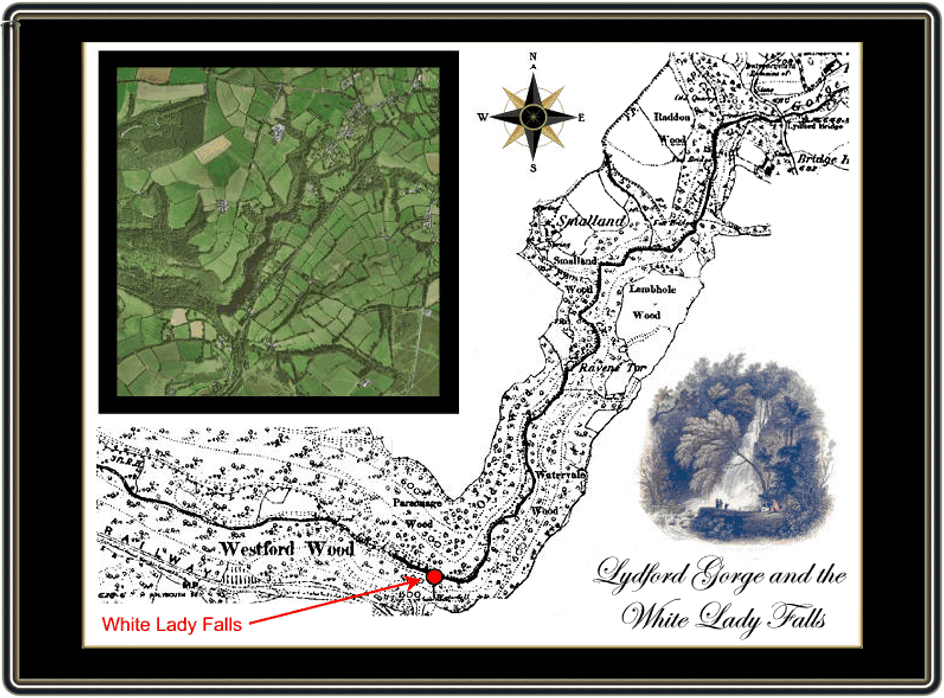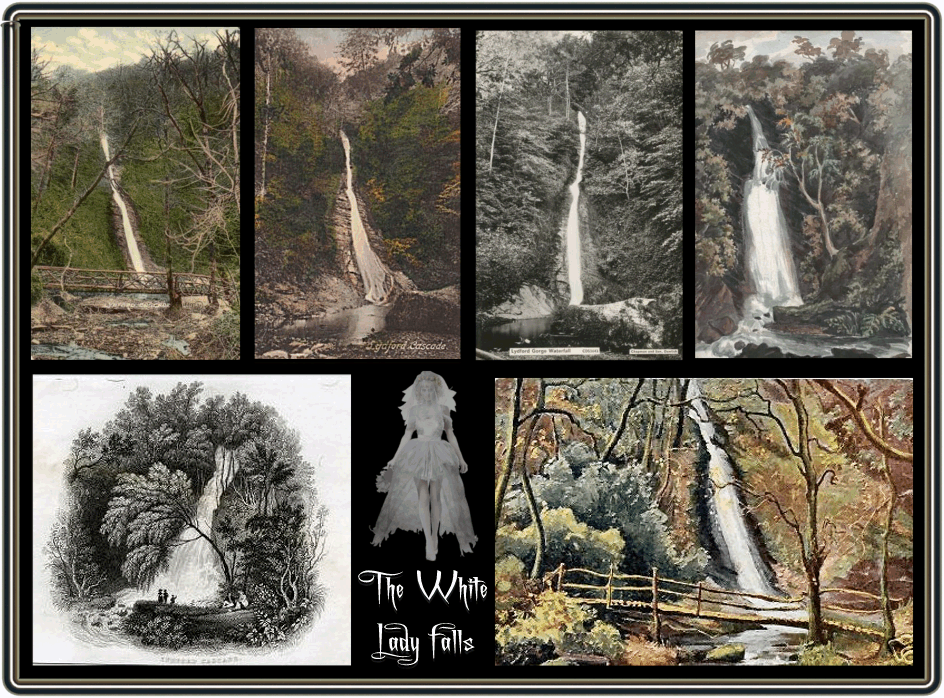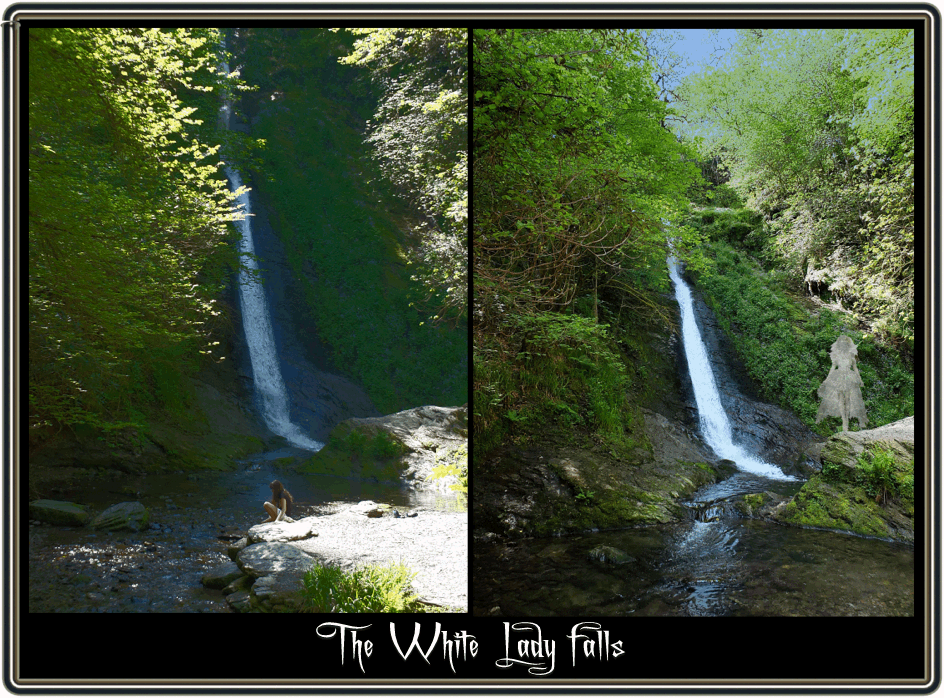
I think when anybody visits an area they always like to see the highest, longest, shortest, deepest or oldest features that are on offer. In this light, the longest waterfall in Devon is the White Lady falls which can be found at the southern end of Lydford Gorge. The main source of water for the falls is the River Burn which rises about a kilometre away on Black Down. The White Lady falls were formed when the River Lyd, having enlarged its valley upstream, forced its way into the valley of the Burn and captured its upper reaches. Having done so, the Lyd then deepened the gorge thus slowly creating the falls. This process is known as ‘river capture’ and the point at where it occurred, the ‘elbow of capture, (Perkins, 1984, p.60).
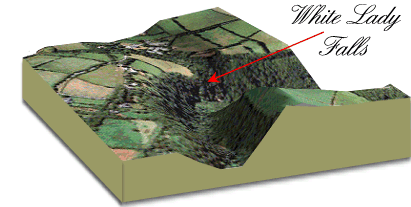
As noted above, the 100m falls are said to be the longest in Devon, if not the entire south-west and for that very reason have over the centuries become, along with the gorge, a popular haunt for tourists. During the 1500s the gorge was home to a gang of supposed cutthroats known as the Gubbins’ who lived in the caves which can be found deep down in the rocky cliffs. There reputation was such that nobody dared venture anywhere near the area for fear of their lives. However, eventually a combination of the law, Jesuits and inbreeding saw the clan finally dispersed to more socially acceptable lifestyles, thus leaving the gorge a safe place which opened the gateway for visitors.
Ok, having briefly looked at the gorge it will now be useful to focus on the topic of the page, namely – the White Lady Falls. The earliest description I have been able to find comes sometime in the mid 1700s:
‘About a M. Distance from this Place (Lydford Bridge), is another natural phænomenon still more remarkable, namely, a Cataract or Fall of Water, from a Height of near 100 F. The water comes from a Mill at some Distance, and after a declining Course arrives at the Edge of the Precipice, or steep Rock, from whence it projects in a very beautiful Manner, and strikes upon a part of the Cliff standing out some small Distance beyond the Brink of the Precipice, by which it is somewhat divided, and falls from thence in a wider Cataract to the Bottom, where it has formed a deep Bason in the Ground,’, (Luckombe, 1764, p.15).
During the mid 1700s the popular pastime of the rich was the ‘Grand Tour’ of Europe, anybody who was anybody made the tour and anybody who was nobody didn’t. It was very much the thing to do and more importantly being seen to do it, that was until William Gilpin came along. In 1770 he toured around the Wye Valley and in a book of 1782 he described the dramatic scenery he viewed on his travels. Gilpin also strongly advocated that there was just as much dramatic scenery to be found in Britain as there was on the Grand Tour. This idea soon caught on and led to the ‘Picturesque Movement’ being formed and gradually the wealthy, leisured classes going in search of the British picturesque. They were searching for dramatic landscapes, gothic ruins, rustic scenes and peasant folk and found them usually in the upland regions of the country. Dartmoor was no exception to this and in fact William Gilpin himself visited the White Lady falls sometime in the early 1800s:
‘The fall of the river which brought us hither, and which is the least considerable part of the scenery, (for we heard nothing of those noble views) is a mere garden-scene. The steep woody hill, whose shaggy sides we had descended, form at the bottom, in one of its envelopes, a fort of little woody theatre; rather indeed too lofty when compared with its breadth, if Nature had been as exact as art would have been, in observing proportion, down the centre part of it, which is lined with smooth rock, the river falls. This rocky cheek is narrow at the top, but widens as it descends, taking probably the form of the stream when it is full. At the time we saw it, it was rather a spout than a cascade; for though it slides down a hundred and eighty feet, it does not meet one obstruction in its whole course, except a little cheek in the middle. When springs are low, and the water has not quantity enough to push itself forward in one current, I have been told, it sometimes falls in various little streams against the irregularities of the rock, and is dashed into a kind of vapoury rain, which has good effect. This cascade, it seems, is not formed by the waters of the Lyd, as we supposed from its name; but by a little stream, which runs into that river, rising in the higher grounds, at the distance of about two miles from the cascade,‘, (Gilpin, 1808, pp. 186 – 187).
I think it fair to say from Gilpin’s description of the falls that he was not too impressed despite the fact that he generously added 80 feet to their height. Nevertheless, he obviously said enough to create the desire for those in search of the picturesque to seek out the gorge and the White Lady Falls. As has always been the case, along with visitors comes the need for various local service industries and the falls were no exception. In 1811 a geologist named Dulac visited the falls and wrote the following description:
‘At Lidford I had been directed to a certain farm-house, where I might obtain a guide to the cascade which Mr. Hill had mentioned to me. After having passed over the bridge, I crossed the hill beyond it, and came to a vale, wherein flow several rivulets; one of these, proceeding from Dartmoor, was then limpid, notwithstanding the frequent showers of the proceeding days; but the others formed along the opposite hills, were turbid. At the top of a slope turning towards the valley of the Lyd, a space had been excavated to receive all these rivulets for the use of a mill; and a little below, their waters, united in a single stream, form the cascade which I was to see.
When I came to the farm, I asked for a guide; and a young girl was sent to accompany me. As the cascade cannot easily be approached from above, it is always viewed from a spot below. The slope down to that spot is so rapid, that though there is a winding path, the descent would be difficult, if the edges of the schistose-strata, inclining inwards, did not form into steps. At the bottom of this descent, I came to a large space, where I saw the Lyd flowing calmly through its own deposits, after having issued from the cleft already described: at the foot of the slope, a great deal of sand has been accumulated by the river, and is now covered with brushwood; the opposite side consists of meadows along its course,’, (Dulac, 1811, pp.149 – 150).
It is clear from his words that whatever the farm he visited were providing a guiding service for anyone wishing to see the spectacle which presumably came at a cost. It is also very interesting to note that he mentions that the rivulets were received at a mill, below which they united into a single stream that formed the falls. This mill was also eluded to by Luckombe in his book of 1764 so clearly it can be assumed that at that time period the various water sources coming down from the moor were being collected in a mill pond before being allowed to journey on to the falls. The Ordnance Survey map of 1888 records Westford as being a corn mill which would have needed a mill pond – see below:
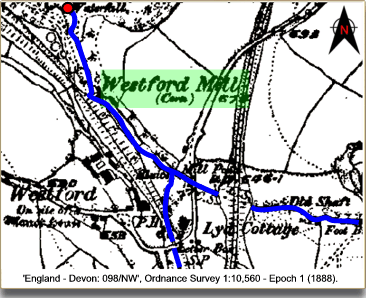
Page makes an interesting comment in his book of 1895 when he states the following: ‘We may add to the effect, though scarcely to the romance, of this fine cascade by inducing the miller to let out the water from his pond.’, (1895, p114). Does this then mean that the flow of water over the White Lady falls was capable of being controlled by the miller? Can it also be assumed that he was providing a service to visitors whereby for an inducement he would release greater volumes of water from his pond in order to enhance the spectacle of the falls? If this was the case then in all reality the falls, at that time, could not be considered as natural as a human hand could control their appearance. This theory is confirmed by an account written in 1846 by Rachel Evans: ‘At the entrance to the dell stood “the mealy miller, a stout carle for nones,” as Chaucer has it, who promised to let out his pond in order to increase the stream.‘, (p.186). She also recounts a tale about a group of visitors who had visited the falls in search of the picturesque, as the ladies were admiring the falls they saw to their consternation a sow and six piglets come spewing over the edge and down the roaring cascade. It transpired that whilst the river was in spate the unfortunate pigs fell into its current and were swept away by its force, (p.188). The whole matter is confirmed along with the early admission fees from the mill, sixpence to gain entry and sixpence to have the water ‘turned on’ as can be seen from the following:
‘After a tedious walk along the road whose hedges prevent one seeing much of the country, and steering through one of the dirtiest of dirty Devonshire farmyards we arrive at the mill. The miller’s wife is expecting us (she is not the least like Tennyson’s Miller’s Wife) ; she is terribly deaf, but has a key which unlocks a gate ; and without propitiating her, Lydford woods and Lydford cascade will remain a sealed book to you. If you give her an extra sixpence, she opens the mill-pool, and then leaves you, with the assurance that the water will be down as soon as you.‘, ( Chanter, 1856, p.45).
Sophie Dixon was also moved to put her visit to the waterfall in a verse called, ‘On Lydford Waterfall‘,: (p.186 – 187).
It could be assumed from his description, that when William Crossing visited the falls at the beginning of the nineteenth century he did not avail himself of the miller’s services:
‘The stream, which has its source near the Okehampton and Tavistock road on Black Down, here falls from a considerable height, which is given as a hundred and ten feet. It does not leap boldly out in the manner of most waterfalls, but slides down the precipitous face of a rock into a little pool, and immediately joins the Lyd. There is consequently no deafening roar, as when a stream falls sheer into the basin below, and is pent between walls of rock. The water glides almost silently down, broken in its course by a ledge, and produces an altogether singular and charming effect. In the wealth of foliage we see an emerald, in the cascade a pearl, set in the rocky crown of Devon, and adding to it far more beauty than any gem from the mines of Peru, or the ocean’s depths, ever lent to a golden symbol of royalty.‘, (Crossing, 1987, p.181).
The Black’s Guide of 1902 states that at that time a charge of 2d was charged to enter the lower part of the gorge which were in the grounds of what was then the Manor Hotel, in later years this was to rise to 6d. The northern end of the gorge was in private ownership but admittance was allowed each Monday for anyone wishing to venture further, (Hope Moncrieff, 1902, p.172).
Oh, one other thing, why is the cascade known as the White Lady Falls? The creepy answer can be found in the dark depths of Dartmoor superstition in the form of a ghost. Locally, it has been said that the spirit of a woman haunts the base of the falls, those that have seen her report that she was dressed in a long white gown. Another idea is that the White Lady will often appear when anyone is drowning in the river and save their lives although I am not too sure I would like to put that one to the test. However, there can be now question that over the centuries people have met their deaths in the river, some intentional and other accidental:
‘The ground, beautiful as it is with fern and flower, is treacherous, and I have myself seen a rash visitor borne away senseless, after being swept down the fall and against the cruel rock which midway, momentarily checks its force. So you will see that there is a reason for the warning, and many pleasure-seekers who visit this ‘Woman in White’ will do well to keep clear of her embrace.’, (Page, 1893, p.259).
In 1896 a farm labourer named Charles Carthew and his son had driven some of their masters’ cattle to Lydford from Coryton. On the way back they decided to take a shortcut through Lydford Woods which took them along the top of the White Lady Falls. Somehow Charles Carthew’s foot slipped and he fell the hundred odd feet head first over the falls. At the time of the accident two men from Tavistock happened to be at the bottom of the falls witnessed the terrible accident. Immediately they rushed over to the man to render assistance and later helped carry Carthew to a nearby farmhouse. A doctor from Tavistock was sent for but sadly there was nothing he could do for the man who died nine hours later. It was reported at the time that he left a widow and six children, one of them being his son who had witnessed his father’s death.
The following year four youths from Plymouth walked up the steep and winding path that lead up to the waterfall. About 20 feet from the top one of the boy slipped and fell the 80 feet into the stream below. It was reported that he actually turned head over heel in his descent. He was taken unconscious to the Manor Hotel Farm where he was put to bed and his wounds dressed by a policeman. He had a cut over his left eye and cuts over his head along with a wound to his hip and substantial bruising over the rest of his body. By that evening he had recovered sufficiently enough to be taken home, – a very lucky escape.
The consensus of opinion is that the falls take their name not from a ghost but from the fact that when in full flow some have imagined that they take the shape of a bride in a white, flowing gown. There is even the idea that this White Lady’ represents the moon goddess Diana, (St. Ledger-Gordon, 1973, p.86).

Chanter, C. 1856. Fenny Combes – A Ramble After Ferns in the Glens and Valleys of Devonshire, London: Lovell Reeve.
Crossing, W. 1987. Gems in a Granite Setting, Exeter: Devon Books.
Dulac, J. A. 1811. Geological Travels in England, London: F. C. & J. Rivington.
Evans, R. 1846. Homes Scenes or Tavistock and its Vicinity, London: Simpkin and Marshall.
Gilpin, W. 1808. Observations on the Western Parts of England, London: Cadell & Davies.
Hope Moncrieff, A. (ed.) 1902. Black’s Guide to Devonshire, London: Adam & Charles Black.
Luckombe, P. 1764. The Beauties of England, London: Davis & Reymers.
Page, J. Ll. W. 1895. An Exploration of Dartmoor, Seeley & Co. Ltd.: London.
Page, J. Ll. W. 1893. The Rivers of Devon, London: Seeley and Co.
Perkins, J. W. 1984. Geology Explained: Dartmoor and the Tamar Valley, Newton Abbot: David and Charles.
St. Ledger-Gordon, R. 1973. The Witchcraft and Folklore of Dartmoor, Wakefield: EP Publishing Ltd.
Williams, T. H. 1804. Picturesque Excursions in Devon and Cornwall, London: J. Murray
 Legendary Dartmoor The many aspects past and present of Dartmoor
Legendary Dartmoor The many aspects past and present of Dartmoor

